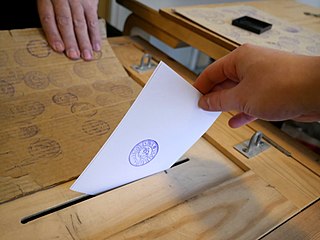The politics of Finland take place within the framework of a parliamentary representative democracy. Finland is a republic whose head of state is President Sauli Niinistö, who leads the nation's foreign policy and is the supreme commander of the Finnish Defence Forces. Finland's head of government is the Prime Minister, who leads the nation's executive branch, called the Finnish Government. Legislative power is vested in the Parliament of Finland, and the Government has limited rights to amend or extend legislation. Because the Constitution of Finland vests power to both the President and Government, the President has veto power over parliamentary decisions, although this power can be overruled by a majority vote in the Parliament.
The Green League, shortened to the Greens, is a green political party in Finland. The Green League is among the largest political parties in Finland. The Greens hold fifteen seats in the Finnish Parliament and one in the European Parliament. The party is a member of the Global Greens and the European Green Party, while its MEP, Heidi Hautala, sits with The Greens–European Free Alliance in the European Parliament. Originally split on whether Finland should join the European Union, the Green League is pro-European and was the first Finnish party in favor of the federalisation of the European Union.

The Parliament of Finland is the unicameral supreme legislature of Finland, founded on 9 May 1906. In accordance with the Constitution of Finland, sovereignty belongs to the people, and that power is vested in the Parliament. The Parliament consists of 200 members, 199 of whom are elected every four years from 13 multi-member districts electing 7-22 MPs using the proportional d'Hondt method. In addition, there is one member from Åland.
The Swedish People's Party of Finland is a liberal-centrist political party in Finland aiming to represent the interests of the minority Swedish-speaking population of Finland. An ethnic catch-all party, the party's main election issue has been since its inception the Swedish-speaking Finns' right to their own language and to maintain the Swedish language's position in Finland. The party was in governmental position 1979–2015 with one or two seats in the government and collaborated with the centre-right as well as the centre-left in the Parliament of Finland. After the 2015 election SFP was left out of the government formed by the three largest parties.

The National Coalition Party is a centre-right political party in Finland considered to be liberal, conservative, and liberal-conservative. Founded in 1918, the National Coalition Party is one of the three largest parties in Finland, along with the Social Democratic Party and the Centre Party. The current party chair is Petteri Orpo, elected on 11 June 2016. The party self-statedly bases its politics on "freedom, responsibility and democracy, equal opportunities, education, supportiveness, tolerance and caring" and supports multiculturalism and gay rights. It is pro-NATO and pro-European as well as a member of the European People's Party (EPP).

There are four types of elections in Finland. Each Finnish citizen at least 18 years of age has the right to vote in each of the elections, which decide the following: the president, the parliament, the MEPs, and the municipal and city councils.

Parliamentary elections were held in Finland on 16 March 2003. The Centre Party led by Anneli Jäätteenmäki overtook the Social Democratic Party (SDP) to become the largest party in the Eduskunta. This was credited mainly to Jäätteenmäki's powerful leadership and modernization of the party still often viewed as agrarian and conservative by many. However, the SDP actually won some seats and increased its share of the vote, losing in the number of total popular votes only by a few thousand.

Parliamentary elections were held in Finland on 21 March 1999. Despite suffering significant losses, the Social Democratic Party (SDP) remained the largest party of the Eduskunta and Paavo Lipponen remained Prime Minister.

Parliamentary elections were held in Finland on 18 March 2007. Early voting was possible from the 7–13 March. The 200 members of the Eduskunta were elected from 15 constituencies.
Parliamentary elections were held in Finland on 17 and 18 March 1945. The broad-based centre-left government of Prime Minister Juho Kusti Paasikivi remained in office after the elections.
Parliamentary elections were held in Finland on 1 and 2 April 1924. Although the Social Democratic Party remained the largest in Parliament with 60 of the 200 seats, Lauri Ingman of the National Coalition Party formed a centre-right majority government in May 1924. It remained intact until the Agrarians left in November 1924. Voter turnout was 57.4%.
Parliamentary elections were held in Finland on 1 and 2 July 1936. Following the election Prime Minister Toivo Mikael Kivimäki of the National Progressive Party was defeated in a confidence vote in September 1936 and resigned in October. Kyösti Kallio of the Agrarian League formed a centrist minority government after Pehr Evind Svinhufvud refused to allow the Social Democrats to join the government. After Svinhufvud's defeat in the February 1937 presidential election, Kallio took office as the new President in March 1937, and he allowed the Social Democrats, Agrarians and Progressives to form the first centre-left or "red soil" Finnish government. Aimo Cajander (Progressive) became Prime Minister, although the real strong men of the government were Finance Minister Väinö Tanner and Defence Minister Juho Niukkanen (Agrarian).
Parliamentary elections were held in Finland on 7 and 8 March 1954.
Parliamentary elections were held in Finland on 4 and 5 February 1962.
Parliamentary elections were held in Finland on 20 and 21 March 1966. The Social Democratic Party (SDP) overtook the Centre Party as the largest faction in Parliament. Rafael Paasio of the SDP subsequently became Prime Minister and formed a popular front government consisting of the SDP, the Centre Party, the People's Democratic League (SKDL), and the Social Democratic Union of Workers and Smallholders (TPSL) in May 1966.
Parliamentary elections were held in Finland on 15 and 16 March 1970.
Parliamentary elections were held in Finland on 20 and 21 March 1983. The elections were widely regarded as a "protest election" because, contrary to expectations, the major parties with the exception of the Social Democratic Party (SDP) performed poorly; the Liberal People's Party (LKP) lost all its seats in the Eduskunta, while the Finnish Rural Party (SMP) more than doubled its seat tally and the Greens won seats for the first time. The SMP's success was credited, at least in part, to voter distaste for some mainstream parties because of political scandals; no significant policy differences emerged in the election campaign. The SDP won 57 seats, the best performance by a party since World War II.

Two-stage presidential elections were held in Finland in 1968. On 15 and 16 January the public elected presidential electors to an electoral college. They in turn elected the President. The result was a victory for Urho Kekkonen, who won on the first ballot. The turnout for the popular vote was 70.2.











